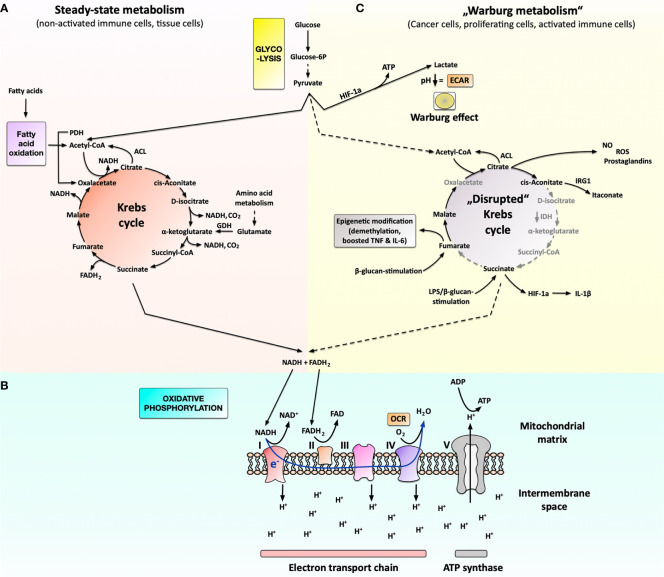Figure 1.
Cellular metabolism under steady-state conditions and metabolic changes associated with cancer cells, proliferating cells, or activated immune cells. Under steady-state conditions (A), cells take up glucose from their medium and metabolize it to pyruvate in a cytoplasmic process called glycolysis. Pyruvate is subsequently imported into the mitochondria, where it is used in the Krebs cycle to generate the reduction equivalents NADH and FADH2. Besides glucose, the Krebs cycle can also be replenished by acetyl-CoA derived from fatty acid oxidation (FAO) or glutamate derived from amino acid metabolism. NADH and FADH2 generated in the Krebs cycle are then used in the oxidative phosphorylation to generate energy (B). Here oxygen is used as the terminal electron acceptor in the electron transport chain (consisting of complexes I through IV) to generate a proton gradient over the inner mitochondrial membrane (measured as oxygen consumption rate (OCR)). This proton gradient drives the generation of ATP via the ATP-synthase complex. Under certain conditions, cancer cells, strongly proliferating cells, or activated immune cells switch their metabolism to predominantly produce lactate from glucose instead of fully oxidizing glucose into CO2 in the mitochondrion (C). The produced lactate is secreted from the cell, leading to an extracellular pH decrease that can be measured as extracellular acidification rate (ECAR). Moreover, the lack of pyruvate results in a “disrupted” Krebs cycle, which the activated immune cells use to generate important biosynthetic intermediates needed for immune cell effector function such as prostaglandins, NO, ROS, or itaconate. Additionally, fumarate and acetyl-CoA (generated, for example, from citrate via the ATP-citrate lyase, ACL) can be used for epigenetic modification. For more information see main text. FAO, fatty acid oxidation; ROS, reactive oxygen species; NO, nitric oxide; FAS, fatty acid synthesis; PDH, pyruvate dehydrogenase; ACL, ATP-citrate lyase; GDH, glutamate dehydrogenase; IDH, isocitrate dehydrogenase; IRG1, immune-responsive gene 1; HIF-1a, hypoxia-inducible factor 1a; OCR, oxygen consumption rate; ECAR, extracellular acidification rate; I to IV, complex I to IV.

